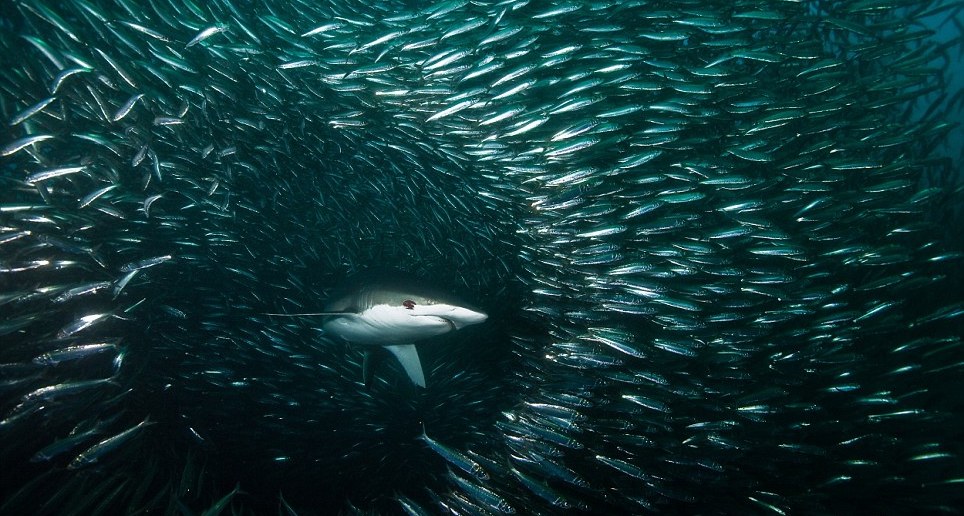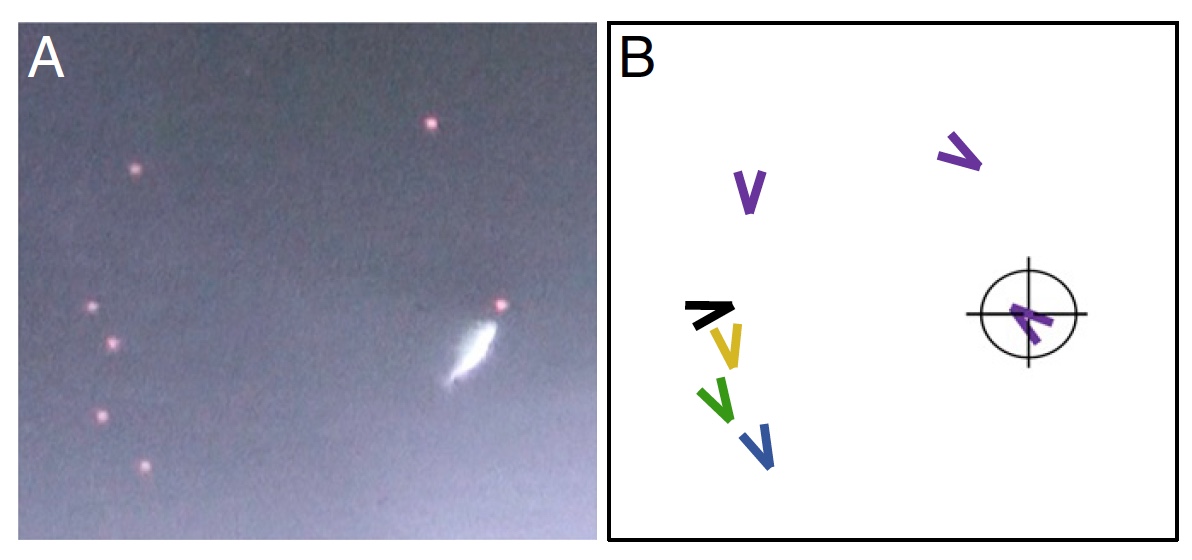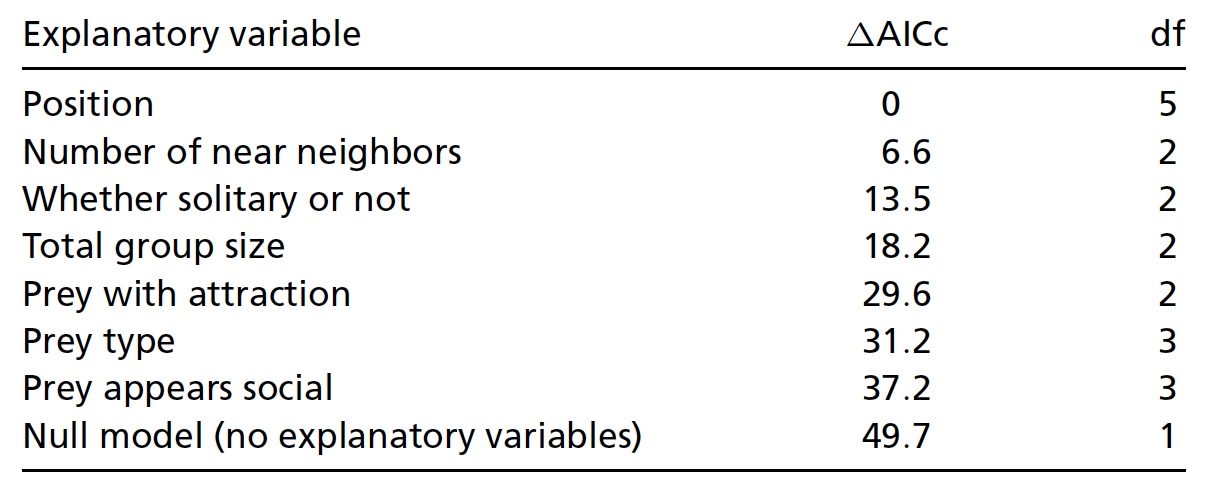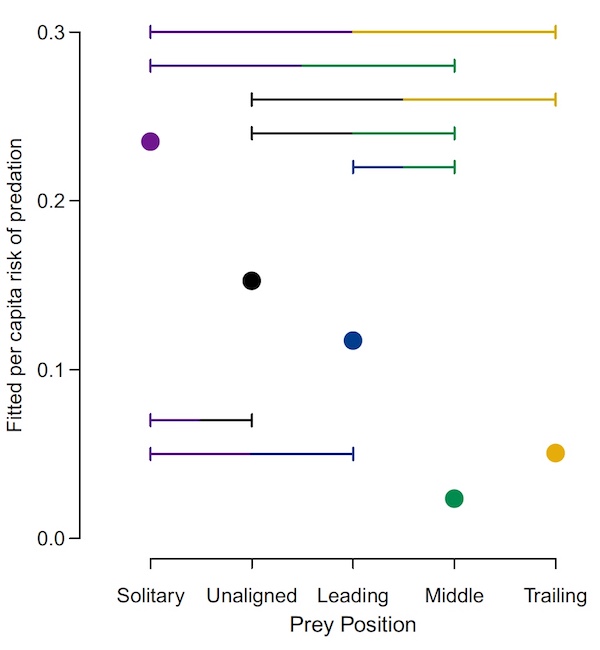The first in the group - the first to fall: assessment of leadership risks in self-organized groups of animals

A bunch of twigs is much more difficult to break than one twig. This metaphor in its various variations tells us that to cope with something alone will be much more difficult than in a group. And in many ways this is true, but not so simple. In the wild, animals, carnivores and herbivores, often gather in groups, flocks, schools, etc. But unlike metaphorical rods, all members of the group are not equivalent, for there are leaders and followers: someone zealously runs forward, someone lurks in the center, and someone weaves in the tail. And here the question arises - what is the price of leadership and what are the benefits, especially if the species of animals that are someone's favorite food is considered.
Today we will get acquainted with a study in which scientists conducted a number of unusual experiments with predatory fish and an artificial school of fish, which allowed us to determine the positive and negative sides of the position in the group under the prism of the prey-predator connection. What is more fatal in the queue, what are the pros and cons of leadership, what does a school of fish look like through the eyes of a predator? We will find answers to all these questions in the report of scientists. Go.
Study basis
As I said earlier, many species of living organisms on the planet are gathered in groups. It’s easier to deal with all the hardships of life in the wild: penguins can survive the terrible cold by gathering in dense groups and warming each other with the warmth of their bodies; the pride of lions hunts together, tracking, surrounding, and intercepting prey, which increases the chances of success; the chaotic (but not random) movement of the flock of small birds greatly interferes with birds of prey hunting them, etc.
Emperor penguins confronting a terrible cold, wind and many months of night.
And, again, in many groups there is one individual that leads all the others, although not always consciously. In self-organized groups (birds or fish), such an individual is located at the head of the group, that is, in front. This situation gives the leader the first opportunity to receive information about the environment (the presence of food, barriers, dangers, etc.), therefore he can make decisions that can affect the actions of the whole group. The main benefit for the leading individual lies precisely in the massiveness of the group led by it, which performs the necessary actions to maintain the life of the leader and group at the same time.
Scientists have always called predators the main drawback of leadership in moving groups of animals, because the front of the flock / school can face danger much more often, and it is easier for predators to navigate the leading individuals during hunting. However, no experiments have been carried out previously in order to confirm or refute this theory.
Self-organized flock of starlings: a spectacle of incredible beauty.
The observations, which can confirm the theory of leadership, are very ambiguous. Researchers note that the determination of the leaders and followers in self-organized groups of animals occurs precisely due to the self-organization of the entire group, but leadership and following (after the leader) are associated with other factors. Most often, a tendency to leadership is associated with determination driven by more information or more need. That is, the position at the head of the group is most often taken by larger, more hungry, less risky and less social individuals. Similar traits can be dangerous for individuals. In other words, it is difficult to assess which is more dangerous - leadership in the group or just the front of the group.
The question also arises: if being a leader is so dangerous, then maybe you should leave the group? Perhaps loneliness will be safer than living in a pack. Both the first and the second options have advantages and disadvantages that relate to predators. However, in order to leave the group, the individual must completely change its priorities from social to focused (i.e. survival). On the other hand, if being a leader in a group is still a bit safer than swimming by yourself, then social behavior becomes a priority.
Many questions, few observations, as we already understood. Therefore, scientists decided to put everything in its place and understand what and how it works in the social sphere of groups of animals that are attacked by predators. For this, a special system of artificial virtual mining was developed. Having full control over the behavior of each of the units in this group, scientists were able to understand the actions of the predator in relation to the leaders and followers, as well as to units separated from the group.
Study preparation
The predatory fish of the stickleback caught in the Carey River (England) acted as living participants in the experiment. In the laboratory, they were placed in glass aquariums (40x70x35 cm) with a flowing recirculation system and a temperature of 15-16 ° C. Each of the aquariums was inhabited by approximately 40 individuals, which were regularly fed twice a day (except for the days when the tests were conducted).
The projection of agent modeling * on the front wall of the aquarium was used as a prey , which made it possible to fully observe the tests. Scientists used the existing one, which they changed through Netlogo 5.0.5, as the basis of their behavioral model.
Agent modeling * is a simulation method that studies the behavior of decentralized agents and the effect of such behavior on the behavior of the system as a whole.The artificial extraction group consisted of 1 leader, 4 followers and 2 asocial units. The leader and followers were programmed so as not to react to the behavior of antisocial units.
Each slave unit was tied to a leader and other slaves so that the distance between them was 6.5 cm. The slave units could also act as a leader, if that was not nearby. Thus, the movement of the group has always been from head to tail, that is, there has always been a leader and 1-2 driven units.

Image No. 1: A - the stickleback attacks the designed point (artificial production) on the aquarium wall; In - the position and trajectory of the movement of artificial extraction (color determines the type of unit).
A small explanation regarding the color distribution of unit types in image 1B :
- violet - a solitary (asocial) unit (absence of other units within the threshold distance);
- black - wrong direction (there are adjacent units within the threshold distance, but move along a path that does not coincide with the black unit);
- blue - the leading (leading) unit;
- green - a unit in the middle of the group;
- yellow is the unit at the tail of the group.
Behavioral rules were applied that regulated the types of production units, which made it possible to obtain different behaviors of the entire system. Thus, the predator (fish) had the opportunity to choose between a leader, driven or asocial unit. The initial position of all units was randomized. All units were presented on the screen in the form of red dots (2.5 mm), reminiscent, according to scientists, of Daphnia (planktonic crustacean).
 Daphnia
DaphniaWhen the system was completely ready, one fish was placed in the test aquarium (as we recall, hungry). The fact of the attack on the unit was the acceleration of the fish in its direction, the opening of the mouth and contact with the screen on which the unit was projected.
Experiment Results
A total of 133 out of 201 fish attacked artificial prey at least once during test runs, each lasting 10 minutes. In order to minimize the behavioral changes in the predator associated with the inability to eat virtual prey, scientists took into account only one attack per test in further calculations.
To determine which virtual prey behavior was decisive in prey-predator issues, scientists compared eight binomial generalized linear models that predicted which prey the predatory fish attacked depending on various explanatory variables.

Above is a table of explanatory variables, that is, a table of models that use one or another variable in the calculations: position, number of near neighbors, unit solitude or not (whether solitary or nor), total group size (total pray size), prey with attraction, prey type, prey appears social and null model / no explanatory variables.
AICc * - Akaike information criterion, modified for a small sample size.The analysis showed that the presence of at least some variable is naturally better than their absence at all. Models that used the separation of prey into types (followers, leaders, and antisocial) showed that leaders and hermits are more frequently attacked by predators. But the model in which the leader and followers were in the same category did not receive confirmation by real observations, that is, the risk on the part of predators varies from the type of unit in the group (leader, in the middle of the group or in the tail).
The most indicative was the model that takes into account the victim’s behavior (model units) during the attack, together with the separation of prey by type. In other words, each unit was originally programmed for a specific behavior, that is, type (to be in front, follow the leader or stay away from the whole group). However, the actual behavior during the test itself was much greater.
An increase in group numbers reduced the risk of predator attacks. Moreover, a model that takes into account not only the number, but also the position of an individual unit relative to others, turned out to be more likely. Also probable was a model in which an important role was played not so much by the size of the group as its density, that is, the distance between the individual units.
After analyzing all the possible models, the scientists came to the conclusion that it is necessary to take into account all the possible factors, no matter how strange it sounds. Most attention needs to be paid to behavioral variables rather than numbers and the distance between predator and prey.

Image No. 2: the risk of attack depending on the position of the prey (purple - asocial; black - in the group, but not in the same direction; blue - leading (leaders); green - in the middle of the group and yellow - in the tail of the group).
The greatest risk of being attacked was with asocial units (the purple circle in the graph above). This indicator confirms the theory that leadership is still safer than total isolation from the group. Even a unit that does not move as a whole group is safer than asocial.
If we consider the ideal group, when all units are aligned in one direction, then scientists saw a clear gradation of the degree of risk (from greater to lesser) - at the beginning of the group, in the tail and in the middle. Scientists expected that the degree of risk for units in the middle of the group and in the tail would be significantly different, but this was not so.
It can be assumed that being in the tail is no less dangerous than at the head of a group. Not for nothing that in many horror films the monster often attacks a group of people from the tail. However, these studies suggest that both in the tail and in the middle of the group, the risk of being eaten is about the same, albeit significantly less than at the beginning.
It is worth noting that in the used prey simulation, the behavior of the units was stochastic and changed over time when the unit left or joined the group. Thus, during the simulations of the predator attack, there were quite a lot of prey variations. To account for all these variations, scientists have developed a special test in which a random predator was simulated, choosing prey during each simulation with equal probability. Interestingly, given this randomization, the production model based on its position in / out of the group turned out to be the most acceptable in comparison with others.
Next, scientists needed to find out the mechanism for choosing a victim from a predator. To do this, the risk of attack was calculated depending on the distance to the target of the attack, the difference in the trajectories of motion and bearing * to the nearest neighboring production unit in front (from all production with bearing <90) and behind (from all production with bearing> 90).
Bearing * is the horizontal angle between the northern part of the observer’s meridian and the direction from the observation point to the object.Among all the variables, the greatest explanatory power in predicting the risk of an attack was precisely the distance to the nearest unit before the prey (target of the attack), followed by the factor of the distance to the nearest unit behind the prey and the difference in direction of movement with the nearest unit in front.
Video of observations of several variants of a predator's attack on a certain prey.
The risk of becoming a victim of a predator attack was minimal if the unit was in the middle of the group, the distance between it and the neighboring units in front and behind was small enough, and the direction of movement of all units was the same. Bearing of neighboring units did not have much effect on the risk of attack. In other words, it is enough to be between two units of production to increase your chances of not being eaten.
As a result, according to the modeling data, the predator attacks a certain prey not by chance, but the risk for prey is due to its position in the group, the difference in the direction of movement and the bearing of the neighbors (little influence factor).
In addition, predators can choose who to attack, that is, do not attack immediately. The choice of the victim will depend not only on the available information about the group at the moment, but also when taking into account possible changes in its configuration in the future. That is, the predator can wait for the right moment to attack, based on the behavior pattern of the group or individual prey.
To test this theory, scientists analyzed the results of simulations involving live predators and artificial prey. It was necessary to calculate which patterns of prey behavior were most often used by the predator for attack or he attacked in a random order.
An analysis of the data (more than 19,000 samples) showed that the predator chooses a certain moment for the attack when there are more single units around it.

Image No. 3
The graph above shows the proportions of attacks depending on the position of the prey. Circles are indicators of attacks during experimental observations. The colored areas on the graph show the distribution of the expected proportion of attacks for each prey position: if the predator attacked the victim randomly in the same cases as in the observed attacks (darker areas) or in the selected simulation samples (lighter areas).
If the observed attacks (circles) are outside the colored area, then targeting a predator to a specific prey was selective and not accidental.
For a more detailed acquaintance with the nuances of the study, I strongly recommend that you look into the report of scientists and additional materials to it.
Epilogue
This study is the first real evidence of a theory claiming that an individual at the head of a group is at greater risk of attack by predators. At the same time, the risk can be reduced if the leader is at a sufficiently small distance from the individuals led by him. Scientists also confirmed the fact that being in a group (even in a leadership position) is much safer than moving individually.
Thus, the leader of the group should not only take care of achieving the goal (for example, finding food), but also monitor the integrity of the group, that is, its construction, which is extremely important not only for the individuals he leads, but for his own survival. In the future, the researchers intend to find out exactly what actions the group leader should take to achieve the above goals.
This work, of course, cannot be called a revelation, but it gave real data confirming what was previously only a theory that has not been tested in practice. Being a leader means knowing what the whole group needs. Being a leader is both profitable and dangerous at the same time - you can get to the food first, or you can become the first. Despite the risks that accompany leadership in the wild, animals continue to form groups where there are both followers and leaders. Perhaps, at some genetic level, they understand that the chances of survival in the group are greater than separately, even if you are a leader.
Friday off-top:
The formation of groups in the wild.
The formation of groups in the wild.
Off Top 2.0:
A short animated film that has nothing to do with the article (except for the presence of fish in the roles of a third plan).
A short animated film that has nothing to do with the article (except for the presence of fish in the roles of a third plan).
Thanks for watching, stay curious and have a great weekend everyone, guys. :)
Thank you for staying with us. Do you like our articles? Want to see more interesting materials? Support us by placing an order or recommending it to your friends, a 30% discount for Habr users on a unique analogue of entry-level servers that we invented for you: The whole truth about VPS (KVM) E5-2650 v4 (6 Cores) 10GB DDR4 240GB SSD 1Gbps from $ 20 or how to divide the server? (options are available with RAID1 and RAID10, up to 24 cores and up to 40GB DDR4).
VPS (KVM) E5-2650 v4 (6 Cores) 10GB DDR4 240GB SSD 1Gbps until the summer for free when paying for a period of six months, you can order here .
Dell R730xd 2 times cheaper? Only here2 x Intel Dodeca-Core Xeon E5-2650v4 128GB DDR4 6x480GB SSD 1Gbps 100 TV from $ 249 in the Netherlands and the USA! Read about How to Build Infrastructure Bldg. class using Dell R730xd E5-2650 v4 servers costing 9,000 euros for a penny?
